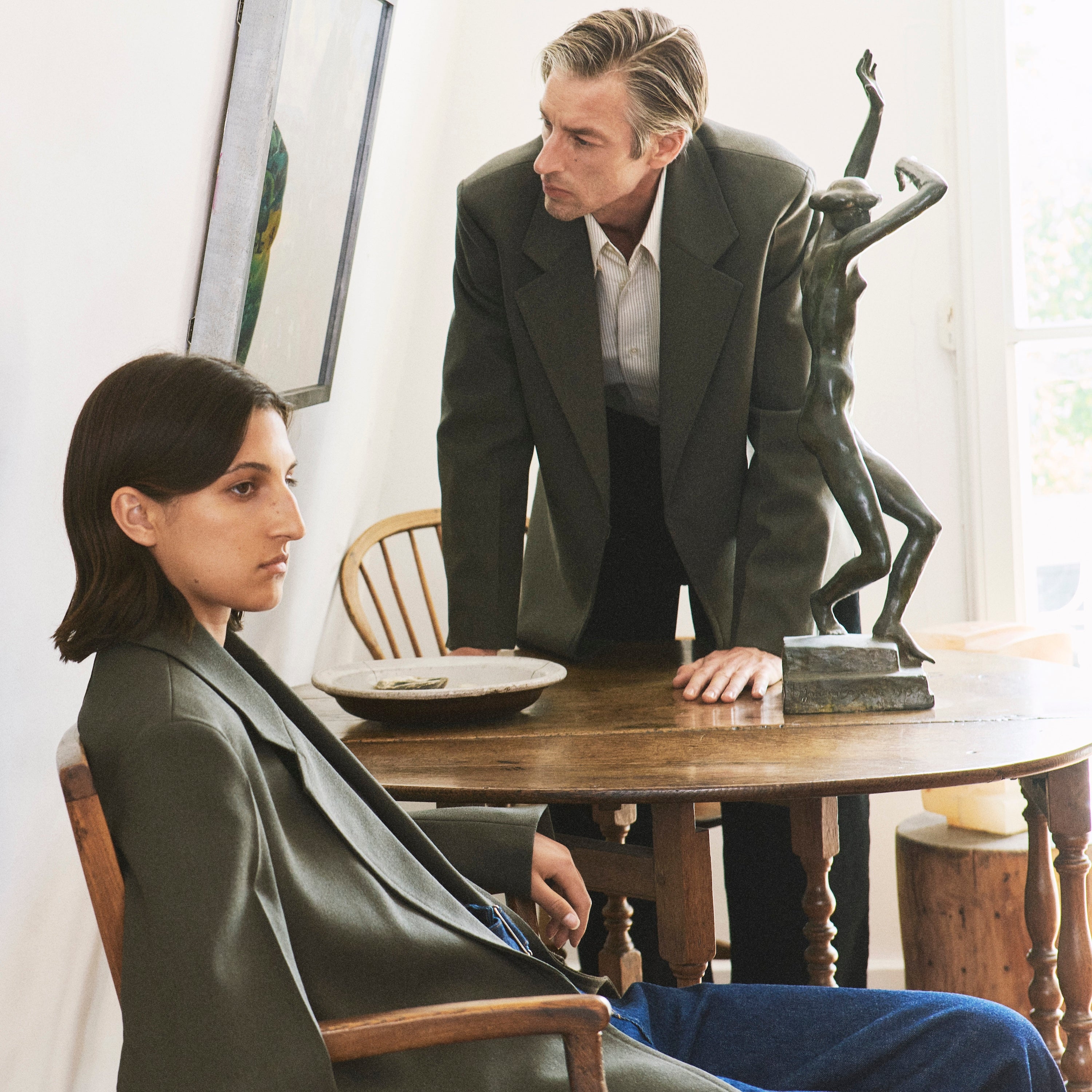



Every great outfit should be built from the trousers upwards. The shape, feel and proportion of your entire ensemble should flow naturally from the correct pair of strides. But for too many men, this has meant limited options and narrow perspectives, and a reluctance to embrace the full glory of a wider leg.
The big trouser has a proud tradition in menswear. In 1925, the Guardian reported from Oxford on the fashion for ‘Oxford Bags’: ‘An aesthete or other leader of advanced thought in tailoring may wear trousers which flap about his feet with a width of 25 inches around the ankle – the width of the ordinary trousers is 16 inches,’ they detailed. ‘Apart from such extreme cases, trousers assume more modest proportions, varying in accordance with the daring and enterprise of the wearer.’ Regular manufacturers couldn’t adapt their machines to produce such a wide cut necessitating bags to be tailor made, so a wider leg conferred a certain status on the wearer.
In Europe in the same decade, one of the most influential portraits in modern photographic history saw the androgynous Helene Abelen – as captured by August Sander in his Menschen des 20. Jahrhunderts (People of the Twentieth Century) series – wearing a voluminous white pant, cinched in at the ankles, sitting high in the waist with a crisp white shirt, a slim black tie and belt and a cigarette clenched between her middle teeth. David Bowie seemed to reference this image for his 1978 Stage tour, where his all-white ensemble paired vast sailors’ trousers cut in to his 26” waist with an open neck, short sleeved white shirt and a sailor’s cap for a cheekily nautical feel (in fairness to Bowie, these were relatively slimline compared to the lower half of his Kansai Yamamoto bodysuit from five years earlier). The accompanying video shows that despite their size, Bowie’s trousers were cut and tailored in a way that made them adapt to his movement. You also see how his stance – feet confidently wide apart and firmly planted – maximised their appearance and impact.
Through the early 80s the scenes around the Wag club and other outgrowths of the soulboy movement resurrected bags, but as the decade continued the Americana trend gravitated more towards denim, the 501 revival and a slimmer cut. The selvedge denim comeback of the late-1990s saw heavy indigo finishes and wider legs paired with bucket turn-ups and the kind of low belting that would fit right in on a construction site, while a concurrent trend for combats and army surplus saw wide-and-loose legs in fashion again. But post-Millennium, skinny denim came back with a vengeance. Propelled by the indie revival, shin-gripping fabric, high-rises, and strangely bunched-up little arses became the norm among British men, a style which has to a large degree persisted.
From a basic dressing point of view this makes little sense: a tight cut on your trousers is restrictive, less comfortable, and more prone to becoming misshapen over time as the seat repeatedly stretches with your daily movements but the legs don’t. On most men, your feet are likely to look abnormally large when anything more substantial than a tennis shoe is paired with a slim trouser. And it gives you a boring straight-up-and-down silhouette. A wider legged trouser achieves the opposite of all these from the first time you put them on.
This reticence to go wide seems to be a particularly European thing – fashion Instagram shows that in Japan and (particularly right now) Korea, the most interestingly dressed men – and more androgynous women – are comfortable with a significantly wider leg than their western counterparts. Whether offsetting a capacious leg with a more fitted top half, or going all-in on the oversize look (supersize scarf, coat you could camp out in etc) the best dressers in those markets are definitely going supersize.
There may be historical reasons for this: the first waves of Japanese men who adopted Ivy League styles through the pages of VAN magazine, and later waves of Ametora (‘American Traditional’) were frequently adopting imported American apparel which was made for bigger men. Other oddities became part of their fashion code – in his book Ametora, David W. Marx references the theory that wider, shorter pants became the norm due to Japanese early-adopters’ unfamiliarity with unsanforised cotton and the subsequent shrinkage that occurred. Other teenagers would buy their trousers new at that same length, which would then shrink further. The end result was that shorter, wider pants became the norm, while a tropical climate further boosted the appeal of a breezier cut. (Studio Nicholson founder Nick Wakeman traces the genesis of SN’s volume pant to a man she fleetingly saw on a busy Tokyo street eight years ago).
To take the plunge with a wider leg, you need to think big and bold. Even trousers routinely billed as being a wide leg or ‘workwear cut’ in the UK rarely go above 8.5” at the ankle. A perfect entry point is our newly released Sorté Pant, an update of our previous Ben Pant. The new model is again made in Portugal, and comes with slanted hand pockets at the seam for more comfortable strolling, is made from Italian peached cotton twill with black, dark navy and tan being continuity pieces and the milk colourway being the seasonal option for Autumn/Winter 20. Crucially, with the Sorté pant it’s not just about width: the subtle cuve to the leg and the front pleats mean that despite the extra volume of fabric, the trousers keep their shape, don’t flap on the leg or bunch at the shoes, and give you an incredibly flattering anchor that you can build the rest of an outfit around. The volume pant is a remarkably simple way to reinvigorate your look, reinvent your silhouette and break with the boredom of most mens’ trousers. Say goodbye to restrictions – both literal and metaphorical.

